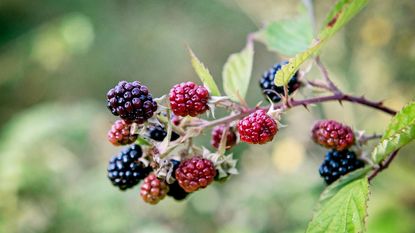The History Of Blackberries In Cultivation


Blackberries have been utilized in Europe for over 2,000 years for culinary and medicinal purposes as well as protective hedgerows. It's no wonder that blackberry history dates so far back. They are part of a widely adapted group of more than 375 species native throughout the temperate northern hemisphere and into South America.
Origin of Blackberries
It is difficult to exactly trace the origin of blackberries, but they probably first originated in Asia, North or South America or in Europe. That doesn't really narrow it down much, but this diverse species of the genus Rubus is difficult to label, as it is the most taxonomically complex of any fruit crop. The original species that existed centuries ago naturally crossbred multiple times with the resulting fruit we see today and is so complex that its origins and lineage can't be traced by genetically backtracking. Blackberries also have the most widespread geographic origin or any fruit crop.
History of Blackberries
Also known as bramble, brummel, and brambleberry, evidence of blackberry consumption can be found all the way back to the Iron Age, some 2,500 years ago, so it is logical to assume that blackberry history dates back over thousands of years. The ancient Romans used blackberries medicinally and Native Americans used them as not only a food source, but medicinally and to dye animal skins. Native Americans also used the canes to make twine. 'Brymbyl' in old English and 'brombeere' in German, ancient Anglo-Saxons used the fruit in primitive pies to celebrate the first fruit feast of Lughnasadh at the end of the summer. Brambles were often planted around European villages to thwart marauders or large animals. Blackberries were also thought to protect against incantations and curses when gathered at a certain phase of the moon. By passing beneath the brambles, children were said to be cured of hernias. Those suffering from boils were also encouraged to crawl through the brambles, although in this case, the "cure" was most likely that the thorns lanced the boils. The ancient Greek physician Galen prescribed a decoction of blackberries for ailments and Palladius writes of a recipe for blackberry syrup made with two parts juice to one part honey. Ancient Greeks also used blackberries to treat symptoms of gout, leading it to be called "goutberry" well into the 18th century.
Additional Blackberry History Information
Until fairly recently, blackberries were considered wild and uncultivated. Then Judge Logan began to crossbreed the berry in 1880 and introduced loganberries, a relative of blackberries. Luther Burbank took a stab at developing a thornless variety in 1921, but the flavor was lacking. Today, the Triple Crown is an excellent flavored thornless berry. Mexico is the leading producer of blackberries. In the United States, Oregon is the leading blackberry, or rather marionberry producer. In the mid-40's, George F. Waldo developed the marionberry, a hybrid of two different varieties of blackberry, and released it commercially as 'Marion' in 1956. While blackberries have been used as a food source and medicine for centuries, today it is primarily used to make sweets such as pies or preserves. It has also historically been used to make wine and cordials as documented by the 1696 London Pharmacopoeia. Lastly, a 10th Arab physician identified the berries as being an aphrodisiac, and I must say I sure do love a plate of blackberry crumble!
Gardening tips, videos, info and more delivered right to your inbox!
Sign up for the Gardening Know How newsletter today and receive a free download of our most popular eBook "How to Grow Delicious Tomatoes."

Amy Grant has been gardening for 30 years and writing for 15. A professional chef and caterer, Amy's area of expertise is culinary gardening.
-
 How To Get Rid Of Mosquitoes In The Garden: 9 Natural Ways To Make Them Buzz Off!
How To Get Rid Of Mosquitoes In The Garden: 9 Natural Ways To Make Them Buzz Off!How to get rid of mosquitoes is on the minds of people in the summer in almost every region of the world. Learn how to repel the pests without toxic chemicals.
By Mary Ellen Ellis
-
 Monkey Orchid Care: How To Grow This Fascinating Species
Monkey Orchid Care: How To Grow This Fascinating SpeciesThe monkey orchid (Dracula simia) bears a remarkable resemblance to its namesake and, with a little know-how, can be successfully grown as a houseplant.
By Bonnie L. Grant